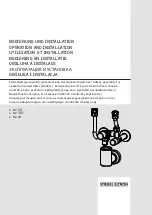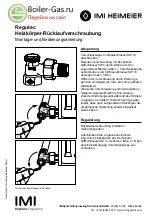
16
24/28/bi
24/28/bi
24/28/bi
24/28/bi
24/28/bi
Symptom
Possible causes
No ignition
Check external wiring
Check external controls
No hot water
Check external controls
No central heating
Check external controls
Frequency
Faults/Status
On every 6-secs
At stand-by with no faults
Flashing 8-times a second
SARA function active
On every 0.5-secs
Temporary fault, e.g.:
●
●
●
●
●
APS fault
●
●
●
●
●
low water pressure
Solid
Active heating/hot water request
GREEN LED
Frequency
Faults/Status
Solid
Check JP1
YELLOW LED
Frequency
Faults/Status
On every 0.5-secs
Final fault, e.g.:
●
●
●
●
●
primary NTC
●
●
●
●
●
water pressure
●
●
●
●
●
fan/flue problem
●
●
●
●
●
ignition/lockout problem
Solid
Limit thermostat
RED LED
●
Light the boiler as described in section 5.6.
●
You should ensure that all radiators or heat
emitters are fully open during the above proce-
dure. This will ensure that the output of the
boiler (burner pressure) is not compromised
due to a high flow temperature. It may be
necessary to fit a jumper tag to the main PCB
(JP2) in order to cancel the timing function for
the 75% output at start up (see fig. 14).
●
Once the combustion analysis test has been
completed, remove the test probe and replace
the protective cap.
7.5
CHECKING THE EXPANSION VESSEL
Carry out the component removal procedure as
described in 6.4. You must ensure that the boiler
is completely drained of waterr.
Using a suitable pressure gauge, remove dust
cap on expansion vessel and check the charge
pressure. The correct charge pressure should be
0.8 BAR ± 0.1 BAR.
If the charge pressure is less, use a suitable
pump to increase the charge.
NOTE
You must ensure the safety valve is in the open
position whilst re-charging takes place. Replace
the dust cap and carry out the relevant commis-
sioning procedure (section 5).
7.6
EXTERNAL FAULTS
Before carrying out any fault-finding or compo-
nent replacement, ensure the fault is not attribut-
able to any aspect of the installation.
7.6.1
INSTALLATION FAULTS
7.7
ELECTRICAL CHECKS
Any electrical checks must be carried out by a
suitably qualified person.
7.7.1
EARTH CONTINUITY TEST
Isolate the appliance from the electrical supply,
and using a suitable multi-meter carry out a
resistance test. Connect test leads between an
appliance earth point and the earth wire of the
appliance supply cable. The resistance should be
less than 1 OHM. If the resistance is greater than
1 OHM check all earth wires and connectors for
continuity and integrity.
7.7.2
SHORT CIRCUIT CHECK
Isolate the appliance from the electrical supply,
and using a suitable multi-meter, carry out a short
circuit test between the Live & Neutral connec-
tions at the appliance terminal strip (fig.16).
Repeat above test on the Live & Earth connec-
tions at the appliance terminal strip (fig.16).
NOTE
Should it be found that the fuse has failed but no
fault is indicated, a detailed continuity. Check will
be required to trace the fault. A visual inspection
of components may also assist in locating the
fault.
7.7.3
POLARITY CHECK
With the appliance connected to the electrical
supply and using a suitable multimeter, carry out
the following voltage tests:
●
Connect test leads between the Live & Neutral
connections at the appliance terminal strip
(fig.16). The meter should read approximately
230V ac. If so proceed to next stage. If not, see
7.7.4.
●
Connect test leads between the Live & Earth
connections at the appliance terminal strip
(fig.16). The meter should read approximately
230V ac. If so proceed to next stage. If not, see
7.7.4.
●
Connect test leads between the Neutral &
Earth connections at the appliance terminal
strip (fig.16). The meter should read approxi-
mately 0 – 15Vac. If so polarity is correct. If not,
see 7.7.4.
7.7.4
REVERSED POLARITY OR SUPPLY FAULT
Repeat the above tests at the appliance isolator,
if testing reveals correct polarity and/or supply at
the isolator, re-check wiring and connections
between the isolator and the appliance
.
Combustion analysis
set point
Fig. 15











































